Ginger
From Wikipedia, the free encyclopedia
For other uses, see Ginger (disambiguation).
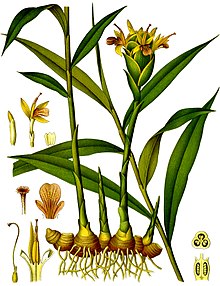
| Ginger | |
|---|---|
| Color plate from Köhler's Medicinal Plants | |
| Scientific classification | |
| Kingdom: | Plantae |
| Clade: | Angiosperms |
| Clade: | Monocots |
| Clade: | Commelinids |
| Order: | Zingiberales |
| Family: | Zingiberaceae |
| Genus: | Zingiber |
| Species: | Z. officinale |
| Binomial name | |
| Zingiber officinale Roscoe 1807[1] | |
Ginger or ginger root is the rhizome of the plant Zingiber officinale, consumed as a delicacy, medicine, or spice. It lends its name to its genus and family (Zingiberaceae). Other notable members of this plant family are turmeric, cardamom, and galangal.
Uses
Ginger produces a hot, fragrant kitchen spice.[5] Young ginger rhizomes are juicy and fleshy with a very mild taste. They are often pickled in vinegar or sherry as a snack or just cooked as an ingredient in many dishes. They can also be steeped in boiling water to make ginger tea, to which honey is often added; sliced orange or lemon fruit may also be added. Ginger can also be made into candy, or ginger wine which has been made commercially since 1740.
Mature ginger rhizomes are fibrous and nearly dry. The juice from old ginger roots is extremely potent[6] and is often used as a spice in Indian recipes, and is a quintessential ingredient of Chinese, Korean, Japanese and many South Asian cuisines for flavoring dishes such as seafood or goat meat andvegetarian cuisine.
Fresh ginger can be substituted for ground ginger at a ratio of 6 to 1, although the flavors of fresh and dried ginger are somewhat different. Powdered dry ginger root is typically used as a flavoring for recipes such as gingerbread, cookies, crackers and cakes, ginger ale, and ginger beer.
Candied ginger, or crystallized ginger, is the root cooked in sugar until soft, and is a type of confectionery.
Fresh ginger may be peeled before eating. For longer-term storage, the ginger can be placed in a plastic bag and refrigerated or frozen.
[edit]Regional use
In Western cuisine, ginger is traditionally used mainly in sweet foods such as ginger ale, gingerbread, ginger snaps, parkin, ginger biscuits and speculaas. A ginger-flavored liqueur called Cantonis produced in Jarnac, France. Green ginger wine is a ginger-flavored wine produced in the United Kingdom, traditionally sold in a green glass bottle. Ginger is also used as a spice added to hot coffee and tea.
In India and Pakistan, ginger is called adrak in Hindi, Punjabi and Urdu, aad in Maithili, aadi in Bhojpuri, aada in Bengali, Adu in Gujarati, hashi shunti(ಹಸಿ ಶುಂಟಿ) in the Kannada, allam (అల్లం) in Telugu, inji (இஞ்சி) in Tamil and Malayalam, inguru (ඉඟුරු) in Sinhalese, alay in Marathi, and aduwa(अदुवा ) inNepali. Fresh ginger is one of the main spices used for making pulse and lentil curries and other vegetable preparations. Fresh, as well as dried, ginger is used to spice tea and coffee, especially in winter. Ginger powder is also used in certain food preparations, particularly for pregnant or nursing women, the most popular one being katlu which is a mixture of gum resin, ghee, nuts, and sugar. Ginger is also consumed in candied and pickled form. InBangladesh, ginger is finely chopped or ground into a paste to use as a base for chicken and meat dishes alongside onion and garlic.
In Burma, ginger is called gyin. It is widely used in cooking and as a main ingredient in traditional medicines. It is also consumed as a salad dish calledgyin-thot, which consists of shredded ginger preserved in oil, and a variety of nuts and seeds. In Indonesia, a beverage called wedang jahe is made from ginger and palm sugar. Indonesians also use ground ginger root, called jahe, as a common ingredient in local recipes. In Malaysia, ginger is called haliaand used in many kinds of dishes, especially a soup. In the Philippines it is brewed into a tea called salabat. In Vietnam, the fresh leaves, finely chopped, can also be added to shrimp-and-yam soup (canh khoai mỡ) as a top garnish and spice to add a much subtler flavor of ginger than the chopped root.
In China, sliced or whole ginger root is often paired with savory dishes such as fish, and chopped ginger root is commonly paired with meat, when it is cooked. However, candied ginger is sometimes a component of Chinese candy boxes, and a tisane can also be prepared from ginger.
In Japan, ginger is pickled to make beni shoga and gari or grated and used raw on tofu or noodles. It is also made into a candy called shoga no satozuke. In the traditional Korean kimchi, ginger is either finely minced or just juiced in order to avoid the fibrous texture and added to the ingredients of the spicy paste just before the fermenting process.
In the Caribbean, ginger is a popular spice for cooking, and making drinks such as sorrel, a seasonal drink made during the Christmas season.Jamaicans make ginger beer both as a carbonated beverage and also fresh in their homes. Ginger tea is often made from fresh ginger, as well as the famous regional specialty Jamaican ginger cake.
On the island of Corfu, Greece, a traditional drink called τσιτσιμπύρα (tsitsibira), a type of ginger beer, is made. The people of Corfu and the rest of the Ionian islands adopted the drink from the British, during the period of the United States of the Ionian Islands.
In Arabic, ginger is called zanjabil, and in some parts of the Middle East, ginger powder is used as a spice for coffee and for milk. In Somaliland, ginger is called sinjibil, and is served in coffee shops in Egypt. In Côte d'Ivoire, ginger is ground and mixed with orange, pineapple and lemon to produce a juice called nyamanku. Ginger powder is a component in hawaij, a spice mix used mostly by Yemenite Jews for soups and coffee.
[edit]Ginger tea
Ginger tea is a beverage in many countries, made from ginger root. In China, the tea is made by boiling peeled and sliced ginger to which brown sugar is often added. Sliced orange or lemon fruit may also be added to give a flavor, and it may be consumed both hot or cold. In Korean cuisine, ginger tea is called saenggang cha (생강차). It can be made either by boiling the ginger or by mixing hot water and preserved sweetened ginger. For the latter, sliced ginger root is stored with honey for a few weeks like jam.[9] In Japanese cuisine it is called shōgayu (生姜湯).[10] In Philippine cuisine it is calledsalabat and served in the relatively cold month of December. From its main ingredient ginger tea derives a flavor that is spicy and stimulating.[11] Ginger, known as Adarak in Hindi, is used frequently in tea made in all parts of India as well.
[edit]Preliminary research
Preliminary research indicates that nine compounds found in ginger may bind to human serotonin receptors which may influence gastrointestinalfunction.[12]
In a 2010 study, daily consumption of ginger was shown to help ease muscle pain associated with exercise by 25%.[13]
Ginger root supplement has been identified in one study to help reduce colon inflammation markers such as PGE2, thus indicating a measure that might affect colon cancer.[14]
In limited studies, ginger was found to be more effective than placebo for treating nausea caused by seasickness, morning sickness andchemotherapy,[15][16][17][18] although ginger was not found superior to placebo for pre-emptively treating post-operative nausea. Data suggests that ginger is mutagenic, and studies warn against taking it during pregnancy,[16] though antimutagenic effects have also been reported. Other preliminary studies showed that ginger may affectarthritis pain or have blood thinning and cholesterol lowering properties, but these effects remain unconfirmed.[19]
Advanced glycation end-products are possibly associated in the development of diabetic cataract for which ginger was effective in preliminary studies, apparently by acting through antiglycating mechanisms.[20][21][22]
Zingerone may have activity against enterotoxigenic Escherichia coli in enterotoxin-induced diarrhea.[15][23]
[edit]Chemistry
The characteristic odor and flavor of ginger is caused by a mixture of zingerone, shogaols and gingerols, volatile oils that compose one to three percent of the weight of fresh ginger. In laboratory animals, the gingerols increase the motility of the gastrointestinal tract and have analgesic, sedative, antipyretic andantibacterial properties.[24] Ginger oil has been shown to prevent skin cancer in mice[25] and a study at the University of Michigan demonstrated that gingerols can kill ovarian cancer cells.[26][27][28] [6]-gingerol (1-[4'-hydroxy-3'-methoxyphenyl]-5-hydroxy-3-decanone) is the major pungent principle of ginger. The chemopreventive potentials of [6]-gingerol present a promising future alternative to expensive and toxic chemotherapeutic agents.[29]
Ginger contains up to three percent of a fragrant essential oil whose main constituents are sesquiterpenoids, with (-)-zingiberene as the main component. Smaller amounts of other sesquiterpenoids (β-sesquiphellandrene, bisabolene and farnesene) and a small monoterpenoid fraction (β-phelladrene, cineol, andcitral) have also been identified.
The pungent taste of ginger is due to nonvolatile phenylpropanoid-derived compounds, particularly gingerols and shogaols, which form from gingerols when ginger is dried or cooked. Zingerone is also produced from gingerols during this process; this compound is less pungent and has a spicy-sweet aroma.[30] Ginger is also a minor chemical irritant, and because of this was used as a horse suppository by pre-World War I mounted regiments for feaguing.
Ginger has a sialagogue action, stimulating the production of saliva, which makes swallowing easier.[31]
[edit]Folk medicine
The traditional medical form of ginger historically was called Jamaica ginger; it was classified as a stimulant and carminative and used frequently for dyspepsia,gastroparesis, slow motility symptoms, constipation, and colic.[32] It was also frequently employed to disguise the taste of medicines.[33]
Some studies indicate ginger may provide short-term relief of pregnancy-related nausea and vomiting.[34] Studies are inconclusive about effects for other forms of nausea or in treating pain from rheumatoid arthritis, osteoarthritis, or joint and muscle injury. Side effects, mostly associated with powdered ginger, are gas, bloating, heartburn, and nausea.[35]
Tea brewed from ginger is a common folk remedy for colds. Ginger ale and ginger beer are also drunk as stomach settlers in countries where the beverages are made.
- In Burma, ginger and a local sweetener made from palm tree juice (htan nyat) are boiled together and taken to prevent the flu.
- In China, ginger is included in several traditional preparations. A drink made with sliced ginger cooked in water with brown sugar or a cola is used as a folk medicine for the common cold.[36] "Ginger eggs" (scrambled eggs with finely diced ginger root) is a common home remedy for coughing.[citation needed] The Chinese also make a kind of dried ginger candy that is fermented in plum juice and sugared, which is also commonly consumed to suppress coughing. Ginger has also been historically used to treat inflammation, which several scientific studies support, though one arthritis trial showed ginger to be no better than a placebo or ibuprofen for treatment of osteoarthritis.[19]
- In Congo, ginger is crushed and mixed with mango tree sap to make tangawisi juice, which is considered a panacea.
- In India, ginger is applied as a paste to the temples to relieve headache, and consumed when suffering from the common cold. Ginger with lemon and black salt is also used for nausea.[34]
- In Indonesia, ginger (jahe in Indonesian) is used as a herbal preparation to reduce fatigue, reducing "winds" in the blood, prevent and cure rheumatism and control poor dietary habits.[citation needed]
- In Nepal, ginger is called aduwa, अदुवा and is widely grown and used throughout the country as a spice for vegetables, used medically to treat cold and also sometimes used to flavor tea.
- In the Philippines, ginger is known as luya and is used as a throat lozenge in traditional medicine to relieve sore throat. It is also brewed into a tea known as salabat.[37][38]
- In the United States, ginger is used to prevent motion and morning sickness.[citation needed] It is recognized as safe by the Food and Drug Administration[citation needed] and is sold as an unregulated dietary supplement. Ginger water is also used to avoid heat cramps.[citation needed]
- In Peru, ginger is sliced in hot water as an infusion for stomach aches as infusión de Kión.
- In Japan it is purported to aid blood circulation.[39] Scientific studies investigating these effects have been inconclusive.[35]
[edit]Nutritional information
| ||||||||||||||||||||||||||||||||||||||||||||||||||
| ||||||||||||||||||||||||||||||||||||||||||||||||||
[edit]Safety
If consumed in reasonable quantities, ginger has few negative side effects,[40] and is on the FDA's "generally recognized as safe" list, though it does interact with some medications, includingwarfarin. Ginger is contraindicated in people suffering from gallstones, as it promotes the production of bile.[33]
Allergic reactions to ginger generally result in a rash, and although generally recognized as safe, ginger can cause heartburn, bloating, gas, belching and nausea, particularly if taken in powdered form. Unchewed fresh ginger may result in intestinal blockage, and individuals who have had ulcers, inflammatory bowel disease or blocked intestines may react badly to large quantities of fresh ginger.[41] Ginger can also adversely affect individuals with gallstones.[19][41] There are also suggestions that ginger may affect blood pressure, clotting, and heart rhythms.[41]
Products in Taiwan made from Hebo Natural Products Limited (禾博天然產物有限公司) of China contained ginger contaminated with DIBP, some 80,000 nutritional supplement capsules made with imported ginger powder were seized by the Public Health Department of Taiwan in June 2011.[42]
[edit]Similar ingredients
Myoga (Zingiber mioga Roscoe) appears in Japanese cuisine; the flower buds are the part eaten.
Another plant in the Zingiberaceae family, galangal, is used for similar purposes as ginger in Thai cuisine. Galangal is also called Thai ginger. Also referred to as galangal, fingerroot (Boesenbergia rotunda), or Chinese ginger or the Thai krachai, is used in cooking and medicine.
A dicotyledonous native species of eastern North America, Asarum canadense, is also known as "wild ginger", and its root has similar aromatic properties, but it is not related to true ginger. The plant also contains aristolochic acid, a carcinogenic compound.[citation needed]
[edit]Production
| Top ten ginger producers – 11 June 2008 | ||||
|---|---|---|---|---|
| Country | Production (tonnes) | |||
| 380,100 | ||||
| 331,393 | ||||
| 192,500 | ||||
| 174,268 | ||||
| 170,125 | ||||
| 152,106 | ||||
| 72,608 | ||||
| 52,000 | ||||
| 27,415 | ||||
| 12,000 | ||||
| World | 1,615,974 | |||
Source: Food And Agricultural Organization of United Nations: Economic And Social Department: The Statistical Division
| ||||

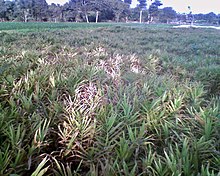
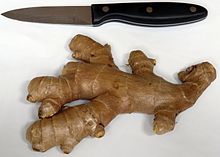
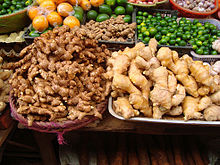
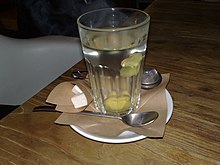




No comments:
Post a Comment